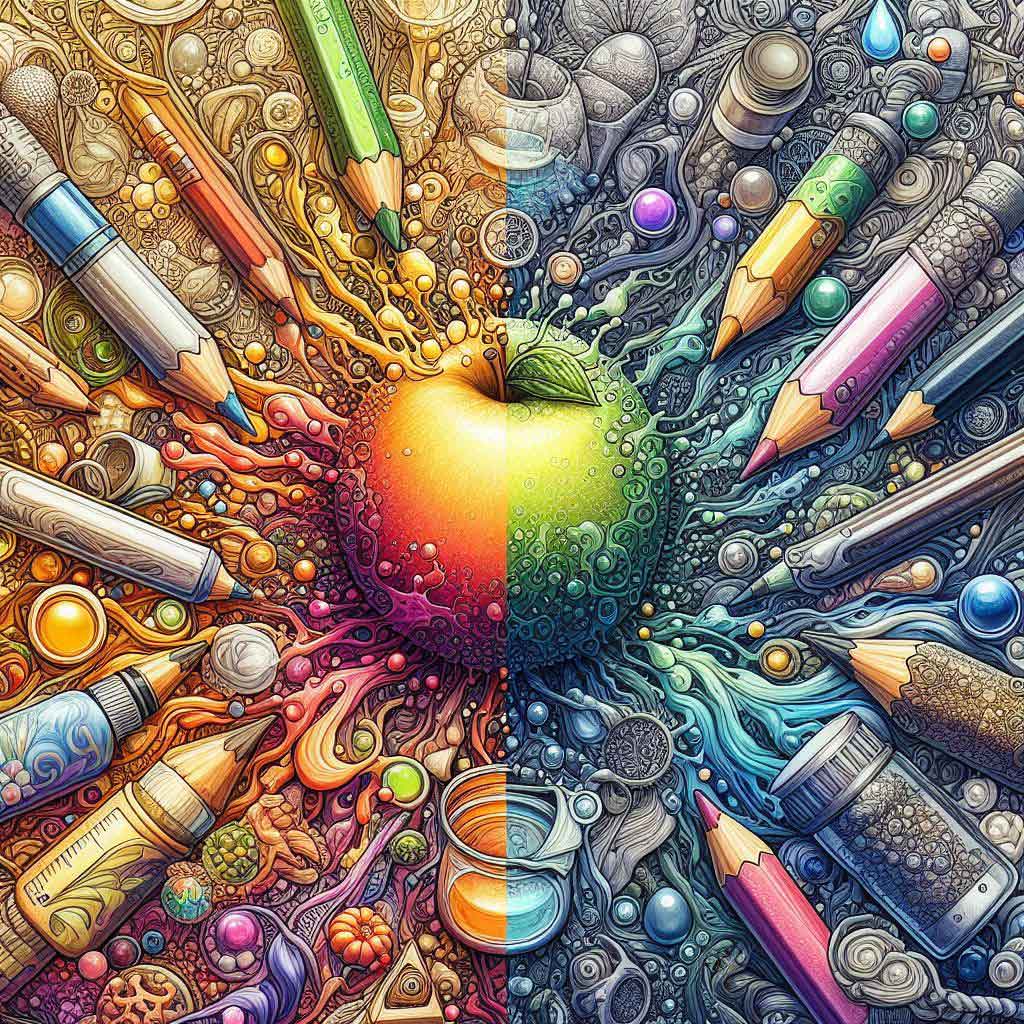This website uses cookies so that we can provide you with the best user experience possible. Cookie information is stored in your browser and performs functions such as recognising you when you return to our website and helping our team to understand which sections of the website you find most interesting and useful.

Discover the Power of Oil-Based Colored Pencils

Exploring Oil-Based Colored Pencils
Oil-based colored pencils are a popular choice among artists due to their unique characteristics and high-quality performance. In this section, we’ll delve into the specifics of Faber-Castell Polychromos and explore the variety of oil-based sets available.
Faber-Castell Polychromos Overview
Faber-Castell Polychromos oil-based colored pencils are internationally renowned for their best-in-class quality. These pencils are favored by professionals and semi-professionals for their outstanding performance and durability. Here are some key features:
- Highest Quality Pigments: Polychromos pencils contain the highest quality pigments, ensuring unsurpassed lightfastness. This means that the colors remain vibrant and do not fade over time.
- Buttery-Smooth Color Laydown: The pencils offer a smooth and creamy application, making it easy to create layered effects, highlights, and transitions.
- Thick 3.8mm Leads: The leads are break-resistant, water-resistant, and smudgeproof. They provide permanent, rich color that is ideal for detailed work.
- Premium California Cedar Wood Casing: The pencils are housed in high-quality wood casings with SV bonding to strengthen the lead and resist breakage. This ensures sharp fine lines and excellent point retention.
| Feature | Description |
|---|---|
| Pigments | Highest quality, unsurpassed lightfastness |
| Color Laydown | Buttery-smooth, easy blending |
| Lead Size | 3.8mm, break and water-resistant |
| Casing | Premium California cedar wood, SV bonding |
For more information on professional color pencils, you can explore our detailed guide.
Variety of Oil-Based Sets

Oil-based colored pencil sets cater to a wide range of preferences and needs, from beginners to professional artists. These sets are available in various sizes, offering a diverse palette of colors to choose from.
- Set Sizes: The sets range from 12 to 240 colors, providing options for every level of artist.
- Vibrant Colors: These sets include premium color pencils with vibrant colors, perfect for drawing, sketching, coloring, and adult coloring books.
- Break-Resistant Cores: The cores are designed to be durable and withstand heavy use, making them suitable for detailed work and intricate designs.
- Soft Cores for Smooth Application: The soft cores allow for smooth coloring and layering, making them ideal for shading, blending, and creating vibrant artwork.
| Set Size | Suitable For | Features |
|---|---|---|
| 12 Colors | Beginners, Kids | Basic color palette, easy to use |
| 24-48 Colors | Hobbyists, Art Enthusiasts | Expanded color range, versatile |
| 72-120 Colors | Semi-Professionals, Professionals | Extensive color options, high-quality pigments |
| 150-240 Colors | Professional Artists | Comprehensive palette, premium performance |
For more options, check out our articles on metallic colored pencils, pastel colored pencils, and neon colored pencils.
These oil-based colored pencils offer unique advantages that make them a preferred choice for many artists. Whether you’re a beginner or a professional, there is a set that will meet your needs and help you create stunning artwork. To learn more about choosing the best pencils, visit our page on best colored pencil brands.
Characteristics of Oil-Based Colored Pencils

Oil-based colored pencils are cherished for their unique qualities that set them apart from other types of colored pencils. Understanding these characteristics can help artists make informed decisions about their tools.
Soft Cores and Smooth Application
Oil-based colored pencils, such as the Faber-Castell Polychromos, are known for their soft cores, which contribute to a smooth and creamy application. The soft core allows for effortless coloring and shading, making these pencils ideal for various artistic techniques.
| Feature | Description |
|---|---|
| Core Material | Oil-based |
| Application | Smooth and creamy |
| Ideal For | Shading, blending, vibrant artwork |
The soft cores of oil-based colored pencils allow for easy layering and blending, enabling artists to create rich and vibrant artwork. This makes them a preferred choice for both professionals and semi-professionals who value precision and quality in their work. For more options, explore our softcore colored pencils section.
Blendability and Layering
One of the standout features of oil-based colored pencils is their exceptional blendability and layering capabilities. The oil-based technology allows these pencils to blend smoothly without the concern of waxy bloom, which is a common issue with wax-based pencils.
| Feature | Oil-Based Colored Pencils |
|---|---|
| Blendability | High |
| Layering | Excellent |
Oil-based colored pencils can be blended using solvents to achieve seamless transitions and layered effects. This versatility makes them suitable for creating highlights, shadows, and intricate details in artwork. Artists can achieve a wide range of effects by adjusting the pressure and layering multiple colors. For more tips on blending and layering, check out our section on colored pencils for shading.
Oil-based colored pencils are also permanent and water-resistant, making them a reliable choice for long-lasting artwork. Unlike water-based pencils, which can be washed off or produce softer, paler colors, oil-based pencils provide deep, strong colors that remain vibrant over time.
For those looking to explore different types of colored pencils and their unique features, we recommend visiting our articles on professional color pencils and best color pencils for artists.
Key Differences: Oil vs. Water-Based

Understanding the differences between oil-based and water-based colored pencils is essential for artists who wish to make informed decisions about their art supplies.
Permanence and Color Intensity
Oil-based colored pencils, such as the Faber-Castell Polychromos, are valued for their permanence and rich color intensity. These pencils are known for their ability to produce deep, vibrant hues that are resistant to smudging and water damage. Once applied, the colors remain steadfast and do not fade easily, making them ideal for professional artworks that require long-lasting quality.
In contrast, water-based colored pencils can be blended with water to create watercolor-like effects. While this feature adds versatility, it also means that the colors can be washed off or altered when exposed to moisture. Water-based pencils tend to produce softer, paler colors compared to the bold and intense shades of oil-based pencils.
| Feature | Oil-Based Colored Pencils | Water-Based Colored Pencils |
|---|---|---|
| Permanence | Permanent, smudgeproof, water-resistant | Can be altered or washed off with water |
| Color Intensity | Deep, vibrant colors | Soft, pale colors |
For artists seeking permanent and intense color, oil-based pencils offer a clear advantage. They are ideal for creating artworks that need to withstand the test of time.
Blending Properties
Oil-based colored pencils have a creamy consistency that allows for smooth blending and layering. They can be easily blended with solvents to create seamless transitions and layered effects. The lack of wax bloom, a common issue with wax-based pencils, ensures that the colors remain vibrant and true to their original hue.
Water-based colored pencils, on the other hand, can be blended with water to achieve unique watercolor effects. This makes them suitable for mixed media projects where traditional watercolor and colored pencil techniques are combined. However, the blending properties of water-based pencils are different from those of oil-based pencils, resulting in softer and more diffuse color transitions.
| Feature | Oil-Based Colored Pencils | Water-Based Colored Pencils |
|---|---|---|
| Blending Method | Blended with solvents | Blended with water |
| Resulting Effects | Smooth, vibrant transitions | Watercolor-like, soft transitions |
For detailed and precise blending, oil-based colored pencils provide exceptional control and versatility. Water-based pencils are better suited for creating fluid and expressive effects.
By understanding the key differences between oil-based and water-based colored pencils, artists can select the right tools for their creative needs. Whether seeking permanence and color intensity or unique blending properties, there is a colored pencil to match every artistic vision. For more insights on the best colored pencil brands, visit our guide on best colored pencil brands.
Debunking the Wax vs. Oil Myth

The debate over wax vs. oil-based colored pencils has been a longstanding one within the art community. However, the reality behind the composition of these pencils is far more intricate than commonly understood.
Complex Core Composition
Colored pencil cores are not composed entirely of either wax or oil. Instead, they utilize a mixture of both wax and oil, along with other binding agents. This blend is essential for achieving the desired properties of the pencils, such as smooth application, blendability, and durability. The specific ingredients and their ratios are closely guarded secrets, often based on recipes that have been used for centuries. Revealing these proprietary formulas could have serious ramifications for the manufacturers.
| Factor | Wax | Oil | Other Ingredients |
|---|---|---|---|
| Composition | Blend | Blend | Varies |
| Core Hardness | Varies | Varies | Depends on mixture |
| Performance | Smoothness | Blendability | Additional properties |
The perception that wax-based colored pencils have softer cores and oil-based colored pencils have harder cores is not entirely accurate. The hardness or softness of a pencil core is determined by various factors, including the type of wax used, the binding agents, and other ingredients. For instance, Derwent Artists colored pencils are marketed as wax pencils but have one of the hardest cores according to tests and reviews.
Marketing vs. Chemical Composition
The distinction between wax and oil-based colored pencils is often a result of marketing decisions rather than chemical composition. The fixation on whether a colored pencil is wax or oil-based among artists is not well understood, even by the Chemists involved in the production of these pencils. The decision to label a pencil as wax or oil-based is made at the marketing level and does not reflect the complex chemistry involved in their creation.
The author of this article, as an art supply reviewer, does not emphasize whether the pencils being reviewed are wax or oil-based due to the complexity and lack of accurate information available on the matter. Instead, the focus is on the pencil’s performance through various tests and observations. For recommendations on professional color pencils and other best colored pencil brands, check out our detailed reviews.
By understanding the complex nature of colored pencil cores and the marketing strategies behind them, artists can make more informed decisions when selecting their materials. Whether opting for softcore colored pencils or colored pencils for shading, the key is to focus on the performance and quality of the pencils rather than the labels.











